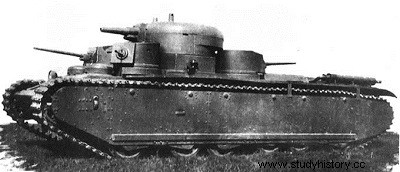
T-35
Type: heavy tank.
Crew: 11 men (for models carrying all the turrets; on some models, some turrets were removed).
Armament (basic model):one 76.2 mm gun; 2 guns of 45 mm:6 machine guns 7.62 mm; a P-40 anti-aircraft machine gun. (Some later models removed part of the secondary armament.)
Armour:
minimum 10mm;
maximum 30mm.
Dimensions:
length: 9.72m;
width: 3.20m;
height: 3.43 m.
Weight in combat order: 50 t. (Some models were lighter)
Ground pressure: 0.78 kg/cm2.
Specific power 10 bhp.
Engine: Water-cooled petrol M-17T V-12 model, developing 507 hp at 2,200 rpm.
Performance:
road speed: 30 km/h;
range: 150km;
vertical obstacle: 1.20 m;
clean cut :3.50 m;
slope: 20°.
Service time: the T-35 was adopted by the Red Army on August 11, 1933. Its production continued until 1939.
At the beginning of the 1930s, while the USSR was engaged in advanced studies concerning armored fighting vehicles, the staff of the Red Army opted for the use of heavy tanks with multiple turrets, which would be grouped in shock formations to break through positions. enemies. This implied the use of enormous "Bronenoster" (battleships) endowed with extraordinary firepower.
Inspired by the general design of the British A-1 tank (no specimen of which was purchased), the prototype of the T-35, weighing 37 t, was built. It had five turrets:a main armed with a 76.2 gun. mm (with 900 shells),-(two secondaries placed diagonally in front and behind the main turret and each armed with a 37 mm gun, and two other small turrets placed on the diagonal opposite to the previous one and each armed with a 7.62 mm machine gun.
To serve this enormous firepower, the tank needed a crew of eleven men.
Later series vehicles had fewer turrets and on a few the 37mm guns were replaced by 45mm ones (with 113 shells each).The final model had sloped wrought armor.
The T-35 was characteristic of the family, predominant in the 1920s and 1930s of multi-turreted heavy tanks, considered the weapon of the future. But in the mid-1930s, following the appearance of numerous anti-tank weapons, it was necessary to reinforce the armor of heavy tanks.
As this measure involved a considerable increase in weight, it could not be applied to tanks with multiple turrets. Two experimental tanks, the SMK and the T-100, were built with two turrets only, but at the same time appeared the experimental tank KV with a single turret, designed by Zh. Kotin.
These three vehicles were tested during the breakthrough of the Mannerheim line (Finno-Soviet war of 1939-40) and it was the KV which proved to be the most effective. Although obsolete when Germany invaded Russia, the T-35 was kept in service until the Battle of Moscow (December 1941), where it fought its last battle.
There were various variants of the T-35, of which about 60 were built and delivered to General Staff Reserve tank brigades. Besides changes in the layout of the armor and the number of weapons, there were some modifications concerning the number of wheels and the type of suspension. All vehicles were equipped with a radio whose loop antenna surrounded the top of the main turret. Several artillery mountings were tested on the chassis of this tank and in particular the heavy Su-14 series, equipped with interchangeable armament.
When the last T-35s were finally decommissioned, at At the end of 1941, their armored hulls, removed from their frames, were slightly modified to be fixed on railway platforms, which throughout the war formed units of armored trains.
